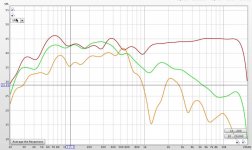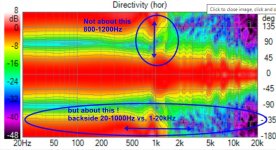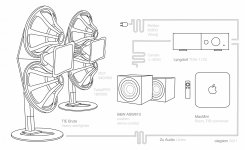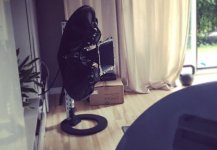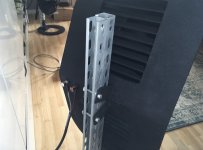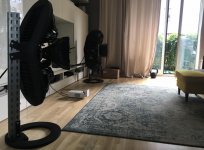This kind of mixed system can give nice polar pattern in half space (0-90deg), and the dipole loss must be equalized ofcourse.
The problemacy arrives when the speaker system is put in a typical modest size room - rear radiation of dipole will add on power response/room response spl with reflected/delayed spatial cues unlike the horn section. This most likely leads to difficulties to get sound tonal balance right and exaggerates spatial differencies in response/tonality. A compromise must be made by eq at spot, but the difference will remain at very sensitive frequency range.
About floor reflections, dipole operation will help only at 60+ deg off-axis! Typical angle to reflection point is only 20-45deg. Tilting drivers will have effect only with a single radiator, not in a dipole pair like TIE Brute.
The problemacy arrives when the speaker system is put in a typical modest size room - rear radiation of dipole will add on power response/room response spl with reflected/delayed spatial cues unlike the horn section. This most likely leads to difficulties to get sound tonal balance right and exaggerates spatial differencies in response/tonality. A compromise must be made by eq at spot, but the difference will remain at very sensitive frequency range.
About floor reflections, dipole operation will help only at 60+ deg off-axis! Typical angle to reflection point is only 20-45deg. Tilting drivers will have effect only with a single radiator, not in a dipole pair like TIE Brute.
The problemacy arrives when the speaker system is put in a typical modest size room - rear radiation of dipole will add on power response/room response spl with reflected/delayed spatial cues unlike the horn section. This most likely leads to difficulties to get sound tonal balance right and exaggerates spatial differencies in response/tonality. A compromise must be made by eq at spot, but the difference will remain at very sensitive frequency range.
In my moderate-sized room with 0.7 m to the wall behind the speakers, I don't hear any problems. Maybe I (and all my guests) have a tolerance for these issue. 🙂 I didn't expect a reduction in floor reflections below 800, I agree that this works at large angles for a dipole, even of this design.
About floor reflections, dipole operation will help only at 60+ deg off-axis! Typical angle to reflection point is only 20-45deg. Tilting drivers will have effect only with a single radiator, not in a dipole pair like TIE Brute.
I tried a quick test: a microphone on the floor (green), a microphone at the level of the horn in the same plane (red), a microphone near the ceiling (2.7 m). I didn't expect a reduction in floor reflections below 800, I agree that this works at large angles for a dipole, even of this design.
Attachments
Last edited:
Nice to hear that you can't hear problems! Anyway here is a 0-180 deg horizontal directivity showing the dipole/horn imbalance, original post by kimmosto
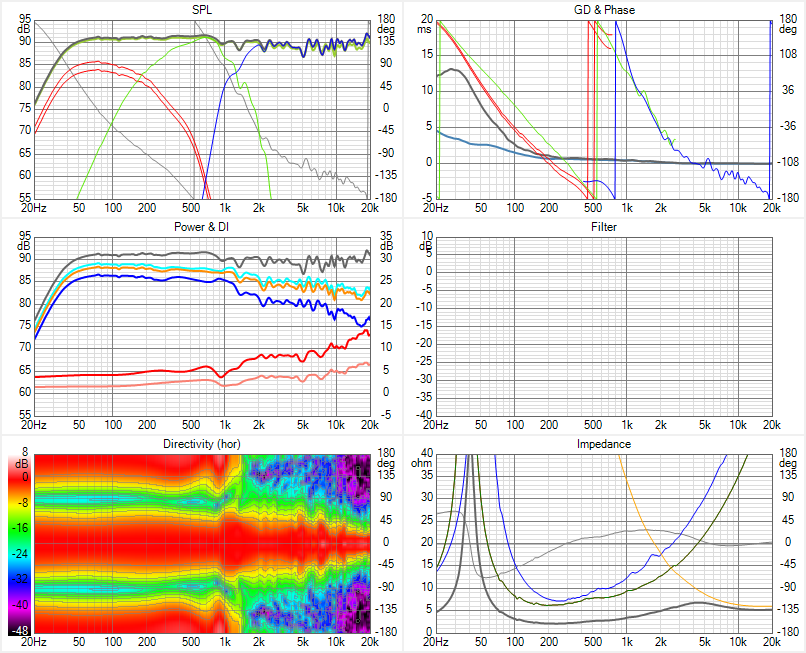
Nice to hear that you can't hear problems! Anyway here is a 0-180 deg horizontal directivity showing the dipole/horn imbalance, original post by kimmosto
From what I can tell, the plots show that the directivity index is relatively smooth, meaning that the radiated power does not represent a major flaw with this kind of hybrid system. This is despite the change from dipole to directive monopole at the crossover point. Although there is a glitch in the DI there I suspect that this is caused by using too small of a horn (judging by the loss of directivity around 1k in the horn).
For me, the main question I have (and why I want to build something like this) is whether the loss of the front wall reflection above the crossover point to the horn will reduce the soundstanging that a good fully-dipole system can deliver.
Last edited:
Nice to hear that you can't hear problems! Anyway here is a 0-180 deg horizontal directivity showing the dipole/horn imbalance, [/URL]
Thank you! I am familiar with this data, and in general it seems obvious...
I can deal with it. 🙂
For me, the main question I have (and why I want to build something like this) is whether the loss of the front wall reflection above the crossover point to the horn will reduce the soundstanging that a good fully-dipole system can deliver.
Back tweeter / horn / fullrange can be added. I didn't hear any benefits. Perhaps the reason is not too much distance to the front wall, but I have no other option.
Last edited:
In kimmosto's attachment, blue curve is power response (full space) and it does have a glitch above 1kHz.
I had this similar issue with AINOgradients first versions that had a horn tweeter crossed around 2-4kHz depending on dsp settings. I was annoyed by treble being super sharp unlike rest of the spectrum. I sounded "hifi" but not natural... Then I added backside tweeter which helped quite a lot, but a planar dipole tweeter was the final solution for me.
At another discussion thread I remember John Kreskowsky saying that if monopole tweeter is highpassed above 4-5kHz to dipole mid, the difference becomes negligible. But I'm sure that depends on speaker placement and wall reflectiveness etc. too. Not to mention psychology (you will hear what you want to)!
I had this similar issue with AINOgradients first versions that had a horn tweeter crossed around 2-4kHz depending on dsp settings. I was annoyed by treble being super sharp unlike rest of the spectrum. I sounded "hifi" but not natural... Then I added backside tweeter which helped quite a lot, but a planar dipole tweeter was the final solution for me.
At another discussion thread I remember John Kreskowsky saying that if monopole tweeter is highpassed above 4-5kHz to dipole mid, the difference becomes negligible. But I'm sure that depends on speaker placement and wall reflectiveness etc. too. Not to mention psychology (you will hear what you want to)!
Attachments
Last edited:
Not to mention psychology (you will hear what you want to)!
For example, you can hear what is shown in the pictures. There is always a bias.

Nice to hear that you can't hear problems! Anyway here is a 0-180 deg horizontal directivity showing the dipole/horn imbalance
[/URL]
OK, if we talk about the upper half of the range and the back radiation. What about the timing? If we delay the upper half of the back radiation (separate driver) in time by 10-15 ms to keep a power response, but make it more independent in time, something like Space Generators Audiokinesis, how will this work in your opinion? This is what I want to try.
Adding extra delay might be worth experimenting, but my guess is it won't be beneficial. Wall reflections will give natural delay anyway. I can not test that, no extra channel free in dsp.
Adding backside tweeter/small horn will not change frontside response (with short gating time) but listening spot response with long gating and csd will be different. Audibly the difference is not dramatic, best to listen to classical/piano and jazz with well recorded cymbals.
Adding backside tweeter/small horn will not change frontside response (with short gating time) but listening spot response with long gating and csd will be different. Audibly the difference is not dramatic, best to listen to classical/piano and jazz with well recorded cymbals.
Adding extra delay might be worth experimenting, but my guess is it won't be beneficial. Wall reflections will give natural delay anyway. I can not test that, no extra channel free in dsp.
That's why I mentioned Space Generators, the idea to send a focused by the horn signal to the ceiling, to form a delay, and the reflections came later, than from nearby walls (in most moderate-sized rooms, they are close and will not provide a delay of >10-15 ms). There are reviews that it works well, creates a sense of bigger space without destroying the direct sound. It seems to me, this equalizes the power response as well, with the feeling that the wall is further away.
Adding backside tweeter/small horn will not change frontside response (with short gating time) but listening spot response with long gating and csd will be different.
Similar as fully dipole speaker does.
That's not true (at all). Do you think sound propagates only in a straight line or something? The front and rear are like two monopoles, and radiate spherically in all directions. So whether you are inside or outside, you will get contributions from both at the listening/mic location until you get to rather high frequency where the driver is very directional.
Sorry, I was a little vague in my post. You are correct Charlie. What I was driving at is that outdoor measurements of OBs tend to tell you little about what they will sound like in your room. IME with OBs the room plays a much larger role in how the speaker will sound than with a closed box speaker (particularly a CD design). So outside measurements of OBs offer less insight than one would hope.
So outside measurements of OBs offer less insight than one would hope.
IMHO measurements by themselves do not give anything, you need an idea why to do them and what to look for.
From what I can tell, the plots show that the directivity index is relatively smooth, meaning that the radiated power does not represent a major flaw with this kind of hybrid system. This is despite the change from dipole to directive monopole at the crossover point. Although there is a glitch in the DI there I suspect that this is caused by using too small of a horn (judging by the loss of directivity around 1k in the horn).
For me, the main question I have (and why I want to build something like this) is whether the loss of the front wall reflection above the crossover point to the horn will reduce the soundstanging that a good fully-dipole system can deliver.
Having heard both types in my room and I can say that the horn with dipole below sounds rather nice. It is my preferred topology. For a long time I ran a SEOS-24 and dipole 18" below the horn, Xover was around 550hz. There are soundstage differences. I'd say it moves the entire stage forward (or backward depending on definition) a bit but not night and day different. I liked the sound better with as low an XOVER that could be tolerated. XOVER too high and vocals did not sound correct but I'm sure you have a different room than mine.
Cool build to the OP!!
Some updates.
New amplifier-Lyngdorf TDAI-1120. It sound great, and there are a lot of useful things on board: equalizers, separately for acoustics and subwoofers, delays for subwoofers (bass is great!), room-correction (a little strange thing, but in general it works), Roon-ready, Airplay, Spotify, coffee roaster... Well, maybe without roasting, but I have to read the manual! To be honest, I'm thrilled.
Small changes in speakers design. I wanted to close the woofers, I didn't like that they were gathering dust. And I decided to try to add a little more baffle size. I like the result, the sound... I don't think it changed much. And that's great!
Changes in the crossover. Now the 2nd order for woofers, after all, it sounds more focused and clean, than the minimalistic crossover before. Although it was also excellent. Just need to adjust something from time to time! 😀
And I added BMR speakers (I had a pair of Cambridge Audio Minx12), with a filter below 1 kHz, as the backside ambient channels (not on photo, latest update).
I decided to test the idea that it is better to support the dipole + horn with a backside tweeter/small horn to equalize the power response. I didn't have a tweeter/horn, so I use a fullrange. I really like the result, the main influence on the perception of space and less room sound, and more natural tonal balance. @Juhazi you were right, it works (but I didn't even argue, it just took a while to try it))!
New amplifier-Lyngdorf TDAI-1120. It sound great, and there are a lot of useful things on board: equalizers, separately for acoustics and subwoofers, delays for subwoofers (bass is great!), room-correction (a little strange thing, but in general it works), Roon-ready, Airplay, Spotify, coffee roaster... Well, maybe without roasting, but I have to read the manual! To be honest, I'm thrilled.
Small changes in speakers design. I wanted to close the woofers, I didn't like that they were gathering dust. And I decided to try to add a little more baffle size. I like the result, the sound... I don't think it changed much. And that's great!
Changes in the crossover. Now the 2nd order for woofers, after all, it sounds more focused and clean, than the minimalistic crossover before. Although it was also excellent. Just need to adjust something from time to time! 😀
And I added BMR speakers (I had a pair of Cambridge Audio Minx12), with a filter below 1 kHz, as the backside ambient channels (not on photo, latest update).
I decided to test the idea that it is better to support the dipole + horn with a backside tweeter/small horn to equalize the power response. I didn't have a tweeter/horn, so I use a fullrange. I really like the result, the main influence on the perception of space and less room sound, and more natural tonal balance. @Juhazi you were right, it works (but I didn't even argue, it just took a while to try it))!
Attachments
Last edited:
Updates.


Improved the power supply of the system, added a large isolation transformer. Crazy stuff, 47 kg, zero WAF🙂 But it works great! It is difficult to describe the changes in words, but all aspects of sound become better and cleaner, I am very happy.

Measurements. The first graph from the listening point, L/R / both. L+R bass Var + spectrogram. Crossover.
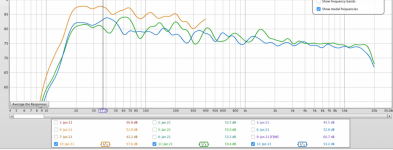
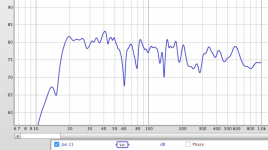
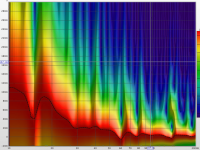
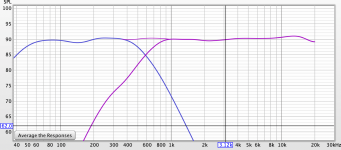
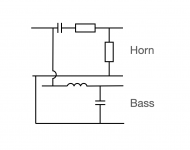
Some records on my channel:
Improved the power supply of the system, added a large isolation transformer. Crazy stuff, 47 kg, zero WAF🙂 But it works great! It is difficult to describe the changes in words, but all aspects of sound become better and cleaner, I am very happy.
Measurements. The first graph from the listening point, L/R / both. L+R bass Var + spectrogram. Crossover.





Some records on my channel:
Here are my observations re back radiation: I don't have first hand experience with back firing tweeters but I played around with open back planars and AMTs. Open back play brings the music into your room. If it is solo piano, it sounds as if the piano is in your room. It is an amazing experience as long as it is simple music like a solo instrument. I have less positive opinions with more complex music though. Although the sound stage is always bigger with open back play, the imaging ie central image suffers with complex music. So much that it may get distracting. Imagine a symphonic orchestra squeezed into your living room.
When you absorb the back wave both effects are reversed.
I really like the open back effect but if I have to pick one I would go with back wave absorbed because I can't live with what open back does to complex music. And I can still enjoy simple music with no HF back radiation.
Although many DIYers say that they prefer full range dipole, most commercial OBs have no back radiation in HF.
A best of both worlds solution would be to have a speaker where you could turn HF back-radiation on and off with ease.
When you absorb the back wave both effects are reversed.
I really like the open back effect but if I have to pick one I would go with back wave absorbed because I can't live with what open back does to complex music. And I can still enjoy simple music with no HF back radiation.
Although many DIYers say that they prefer full range dipole, most commercial OBs have no back radiation in HF.
A best of both worlds solution would be to have a speaker where you could turn HF back-radiation on and off with ease.
I can't live with what open back does to complex music.
Your whole post sounds a lot like the effect of room reverb in general. It can sound flattering with certain solo instruments and calm passages but becomes a nuisance/mess with complex, rapidly-changing passages. The answer, IMO, is to reduce your room reverb time.
- Home
- Loudspeakers
- Multi-Way
- TIE Brute: open-baffle / horn speakers
